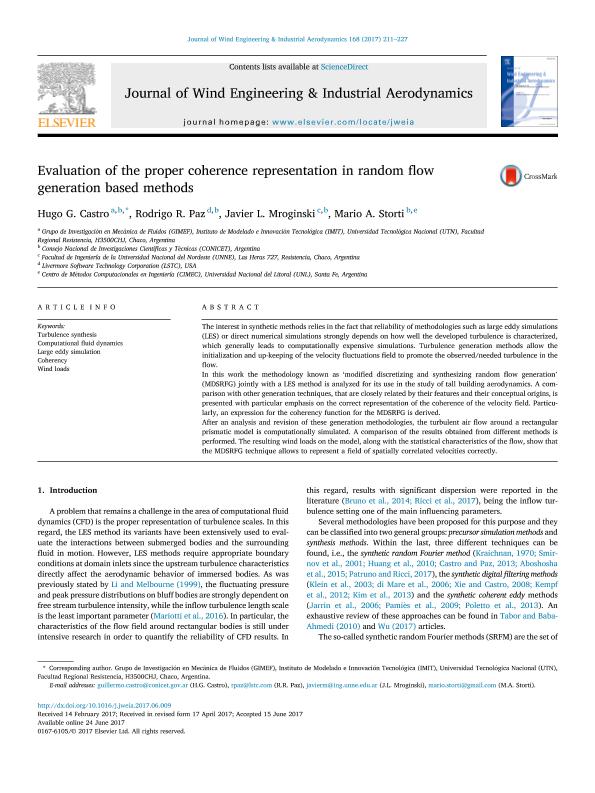Mostrar el registro sencillo del ítem
dc.contributor.author
Castro, Hugo Guillermo

dc.contributor.author
Paz, Rodrigo Rafael

dc.contributor.author
Mroginski, Javier Luis

dc.contributor.author
Storti, Mario Alberto

dc.date.available
2018-03-08T19:19:55Z
dc.date.issued
2017-09
dc.identifier.citation
Castro, Hugo Guillermo; Paz, Rodrigo Rafael; Mroginski, Javier Luis; Storti, Mario Alberto; Evaluation of the proper coherence representation in random flow generation based methods; Elsevier Science; Journal of Wind Engineering and Industrial Aerodynamics; 168; 9-2017; 211-227
dc.identifier.issn
0167-6105
dc.identifier.uri
http://hdl.handle.net/11336/38290
dc.description.abstract
The interest in synthetic methods relies in the fact that reliability of methodologies such as large eddy simulations (LES) or direct numerical simulations strongly depends on how well the developed turbulence is characterized, which generally leads to computationally expensive simulations. Turbulence generation methods allow the initialization and up-keeping of the velocity fluctuations field to promote the observed/needed turbulence in the flow. In this work the methodology known as ‘modified discretizing and synthesizing random flow generation’ (MDSRFG) jointly with a LES method is analyzed for its use in the study of tall building aerodynamics. A comparison with other generation techniques, that are closely related by their features and their conceptual origins, is presented with particular emphasis on the correct representation of the coherence of the velocity field. Particularly, an expression for the coherency function for the MDSRFG is derived. After an analysis and revision of these generation methodologies, the turbulent air flow around a rectangular prismatic model is computationally simulated. A comparison of the results obtained from different methods is performed. The resulting wind loads on the model, along with the statistical characteristics of the flow, show that the MDSRFG technique allows to represent a field of spatially correlated velocities correctly.
dc.format
application/pdf
dc.language.iso
eng
dc.publisher
Elsevier Science

dc.rights
info:eu-repo/semantics/openAccess
dc.rights.uri
https://creativecommons.org/licenses/by-nc-sa/2.5/ar/
dc.subject
Coherency
dc.subject
Computational Fluid Dynamics
dc.subject
Large Eddy Simulation
dc.subject
Turbulence Synthesis
dc.subject
Wind Loads
dc.title
Evaluation of the proper coherence representation in random flow generation based methods
dc.type
info:eu-repo/semantics/article
dc.type
info:ar-repo/semantics/artículo
dc.type
info:eu-repo/semantics/publishedVersion
dc.date.updated
2018-03-07T15:55:28Z
dc.journal.volume
168
dc.journal.pagination
211-227
dc.journal.pais
Países Bajos

dc.journal.ciudad
Amsterdam
dc.description.fil
Fil: Castro, Hugo Guillermo. Consejo Nacional de Investigaciones Científicas y Técnicas; Argentina. Universidad Tecnológica Nacional. Facultad Regional Resistencia. Grupo de Investigación en Mecanica de Fluidos; Argentina
dc.description.fil
Fil: Paz, Rodrigo Rafael. Livermore Software Technology Corporation; Estados Unidos. Consejo Nacional de Investigaciones Científicas y Técnicas. Centro Científico Tecnológico Conicet - Santa Fe. Centro de Investigaciones en Métodos Computacionales. Universidad Nacional del Litoral. Centro de Investigaciones en Métodos Computacionales; Argentina
dc.description.fil
Fil: Mroginski, Javier Luis. Consejo Nacional de Investigaciones Científicas y Técnicas; Argentina. Universidad Nacional del Nordeste. Facultad de Ingeniería; Argentina
dc.description.fil
Fil: Storti, Mario Alberto. Universidad Nacional del Litoral; Argentina. Consejo Nacional de Investigaciones Científicas y Técnicas. Centro Científico Tecnológico Conicet - Santa Fe. Centro de Investigaciones en Métodos Computacionales. Universidad Nacional del Litoral. Centro de Investigaciones en Métodos Computacionales; Argentina
dc.journal.title
Journal of Wind Engineering and Industrial Aerodynamics

dc.relation.alternativeid
info:eu-repo/semantics/altIdentifier/doi/http://dx.doi.org/10.1016/j.jweia.2017.06.009
Archivos asociados
